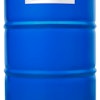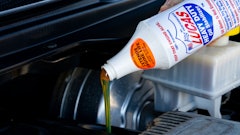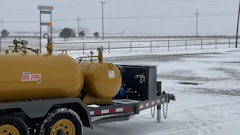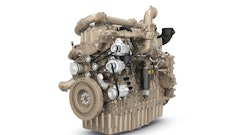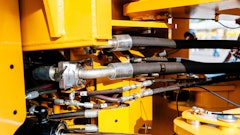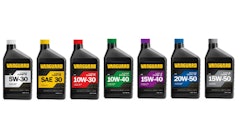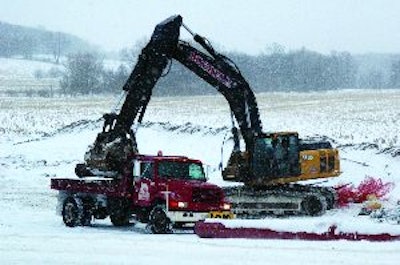
For contractors in the Upper Midwest, record-setting 70°+ temperatures at the beginning of November were followed by snow flurries and below-normal temperatures a few days later. So while the calendar may say it?s December, the unpredictability of the weather ? regardless of where you live ? can make it difficult to know what to do with your fluids program to maximize performance.
That?s why it?s important to anticipate what weather is normally like in your area. ?In places like Wisconsin, at this time of year, you know it won?t stay in the 70s for long,? says Dan Arcy, technical manager, Shell Global Solutions.
All fluids used in heavy-duty equipment are susceptible to poor performance in colder weather, notes Richard Gapinski, BP Lubricants. Colder temperatures can slow or stop their flow, which can cause excessive wear or, in the worst-case scenario, equipment failure.
Although wear actually decreases with thicker fluid, there comes a point where it can become too thick to flow. ?If the viscosity increases severely, the lubricant will cease to flow and damage to the equipment could occur,? says Gapinski. And even if excessive wear doesn?t show up immediately, a few months down the road, you may have a failure that could be related to fluid performance over the winter.
Effects based on fluid types
Transmission and hydraulic fluids are most susceptible to cold temperatures. ?If the temperature drops low enough that these fluids become a semi-solid and no longer flow, the transmission and hydraulic systems wouldn?t operate at all,? says Gapinski. ?If they?re put in motion without the proper lubrication, you can have a lot of expensive repairs.?
Diesel fuel is also more vulnerable to colder ambient temperatures than gasoline, says Arcy. Make sure any fuel you purchase is designed for the temperatures you will be working in for the time frame it takes to empty your storage tanks. ?If a tank lasts a couple of months, consider the typical ambient temperatures for that entire time period,? he says. ?You don?t want it to gel up.?
Pay special attention to biodiesel. It has different flow properties, so talk with your fuel supplier to ensure you?re covered for the winter months.
When it comes to engine oil, be sure to use the correct viscosity as indicated in the operator?s manual. Each engine/equipment manufacturer lists the acceptable viscosity grades based on ambient temperatures.
Many contractors turn to synthetic engine oils during the winter because they maintain better fluidity. ?Synthetics will flow better in cold temperatures,? says Arcy. ?You will be able to get the oil to the critical part of the engine faster, and it will take less energy to start that vehicle.?
Although mineral-based oils are more prone to solidifying in the cold, Group II mineral oils are less susceptible than Group I oils. That?s because Group II oils are more highly refined; wax and other components that can cause the oil to turn into a solid at low temperatures have been removed.
Synthetic oils are becoming more common because the price difference between them and mineral oils is less than it used to be. ?The price is leveling out,? says Gapinski. ?There is less of a price difference, so people are more willing to use synthetic oils. Also, OEM specs are becoming more rigorous. They are driving formulators like us to use more synthetic oils. And in fact, some oil specifications can?t be met without using a synthetic oil.?
Match viscosity ratings to temps
Whether synthetic- or mineral-based, choose an engine oil with a viscosity grade that maintains pumpability when the temperature drops. In general, most will stay fluid to -20° F. But if you live in an area where it can drop to -40° F, you need to pay extra attention. ?There will be a big difference in performance,? says Gapinski. ?For temps below -40° F, you will need a specialty fluid.?
Multi-grade oils, like a 10W-30, will have better low-temperature properties than mono-grade oils, such as an SAE 30. ?That?s because they contain a viscosity modifier,? says Gapinski. ?When these are present, they help flatten the response of an oil to temperature. The higher the viscosity index number, the less the fluid changes with temperature.?
For multi-grade oils, the number in front of the ?W? is a measure of pumping and cranking performance, with each step lower (15W, 10W, 5W, 0W) representing a 5° C (9° F) increase in low-temperature capability, explains Eric Olsen, lubricants technology, engine oils team, Chevron Global Lubricants.
?Generally, an SAE 15W-40 will have good pumpability down to -25° C (-13° F), while an SAE 5W-40 would extend the range down towards -35° C (-31° F),? he says. ?My choice of the word ?generally? is intentional, because the SAE viscosity system was developed using gasoline engines. So for diesels, [it] is correct as a relative ranking system rather than for absolute limits.?
Many truckers in warmer states use SAE 15W-40 year-round, Olsen continues. But in colder climates, some will change to SAE 10W-30 or SAE 5W-40 to help maintain operations as temperatures cool. ?For example, about the time of year footballs start flying, a trucker might notice slower cranking or a few more turns before the engine fires up in the morning,? he says.
?As snow begins to accumulate, it is vital to ensure you are using an oil that will stay liquid,? Olsen asserts. ?The alternative can be sudden engine death. This happens when an oil gels or becomes a semi-solid at low temperatures. If an engine were to start with such a gel in the pan, it would not be long before the oil pump would suck air, leaving the bearings dry to grind themselves apart.?
Use the right mix
Also make sure your coolant is at the proper ratio so it doesn?t freeze. The optimum ratio is 50% coolant and 50% water. Keep a refractometer in your shop to accurately identify the concentration. ?At that ratio, the freezing point is -34° F,? says Arcy. ?If you get a higher concentration of water, your coolant will freeze at a higher temperature.?
?If the expected ambient temperature is going to be below -34° F, you can adjust the freeze point by adding more antifreeze/coolant concentrate,? says Carmen Ulabarro, direct marketing manager, Chevron Global Lubricants. ?However, the maximum recommended amount of glycol should not exceed 60%, since adding too much antifreeze concentrate can actually reduce freeze protection.?
If you?re using a non-extended life coolant, check the inhibitors to ensure cooling system components will be protected. ?If your conventional coolant has been run for more than 250,000 miles, think about changing it out,? Ulabarro advises. ?Over time, the solids in the system can get too high and may create issues with plugging. Also, be sure to check all hoses and fittings and replace any worn hoses and tighten loose clamps. If temperatures are extreme ? below -60° F ? consider using a PG coolant vs. an EG-based coolant, because it has a lower freeze point.?
Beyond fluid selection
There are also certain tasks you can do at startup and shutdown to ensure your equipment will operate properly.
If you know it?s going to be extremely cold the next morning, park equipment indoors at the end of the day if you have that option. ?Try to keep it as warm as possible,? says Gapinski. ?There are also engine heaters that can give you a jump start.?
In addition, check the pour point of any fluids you?re using. (This information is available from product data sheets from the fluid marketer.) The pour point is the point at which the oil is incapable of being poured/stops flowing. ?It?s the responsibility of the customer to know the pour point,? says Gapinski. ?If the temperature is below that number, don?t use the equipment. To avoid damage and a lot of expense, it?s better to go home that day.?
Selecting the right fluids is even more critical if you don?t use a piece of equipment every day. ?If your equipment has sat unused for three or four days, you will want to select a fluid that flows easily so the equipment starts easily,? says Arcy. ?If you use the equipment every day, at startup, run the vehicle to the point where it?s hot.
?Water forms during the combustion process, and when an engine is hot, it will burn it off. But if the engine never gets hot, you will get a buildup of water in some of its cooler parts,? he explains. ?That?s one reason why you also don?t want to idle an engine for long periods of time. The engine just doesn?t get as hot as it should to burn off that condensation. Plus, it?s costing money because you?re burning fuel.?

